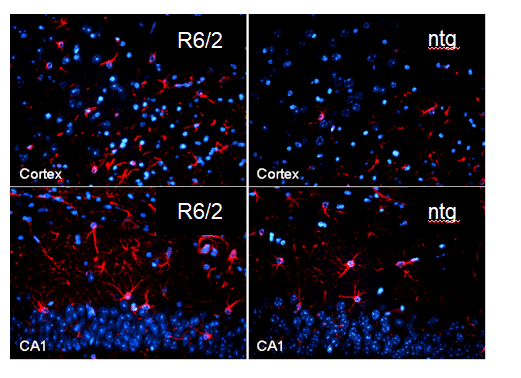R6/2 mice model human Huntington’s disease (HD) by expressing a portion of the human HD gene under human gene promoter elements (1 kb of 5 UTR sequence and exon 1 together with ~120 CAG repeats). Expression of this amino-terminal fragment of the huntingtin protein with its polyglutamine expansion is sufficient to generate the phenotype of human HD.
The most important characteristics of R6/2 mice are:
- HTT aggregates
- Reduced activity
- Motor deficits
- Learning and relearning deficits
- Reduced anxiety
- Neuroinflammation
- Striatal alterations
- Neuronal atrophy
- Mean survival of 100 days
Progressive motor deficits of R6/2 mice start at the age of 6 weeks and can be measured with the RotaRod test. The two choice swim test allows evaluation of cognitive deficits in R6/2 at the age of 10 weeks (Figure 1).

Figure 1 (A): RotaRod performance of R6/2 mice: Motor coordination expressed as time until falling off the rod with progressing age (tg: n = 10; ntg: n = 19); (B) two choice swim test: percentage of wrong choices during 5 training days with 5 trials per day followed by one reversal day with 15 trials (n = 14 per group); two-way ANOVA with Bonferroni`s post hoc test. Mean ± SEM. **p<0.01; ***p<0.001.
Astrocytosis as measure of neuroinflammation in R6/2 mice can be observed in the cortex and hippocampus at the age of 15 weeks (Figure 2).

Figure 2: Astrocytosis in R6/2 mice: R6/2 mice feature increased levels of astrocytosis compared to ntg controls. GFAP (astrocytes, red) plus DAPI (nuclei, blue) in the primary somatosensory cortex and CA1 region of the hippocampus.
Scantox offers a custom-tailored study design for R6/2 mice, and we are flexible to accommodate your special interests. We are also happy to advise you and propose study designs. R6/2 mice show a relevant HD phenotype at the age of 6 weeks. This grants a remarkable fast processing time of your HD study. Furthermore, non-transgenic littermates are available as control animals needed for proper study design.
We are happy to evaluate the efficacy of your compound in the R6/2 mouse model! The most common readouts are:
- Motor deficits
- Survival
- Learning and Reversal learning deficits
- Neuronal atrophy
- Neuroinflammation
- polyQ HTT quantification
Looking for something else? Please contact us!
